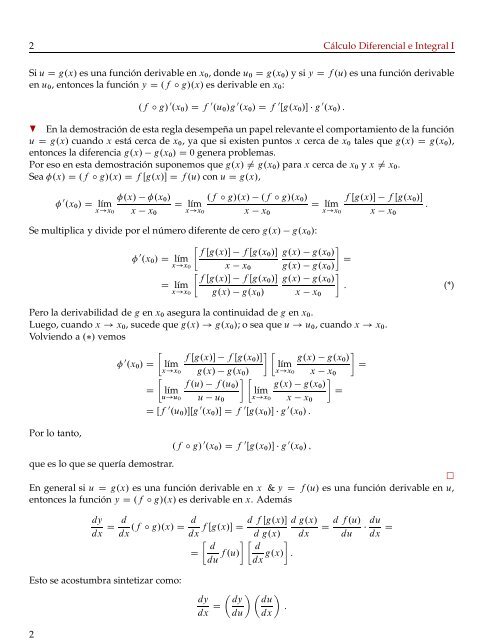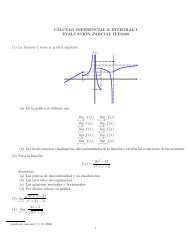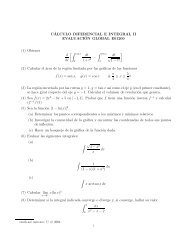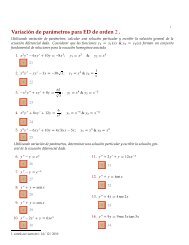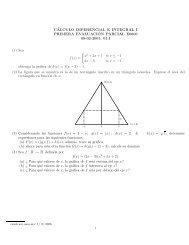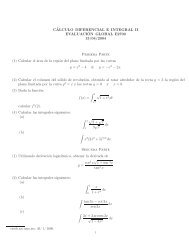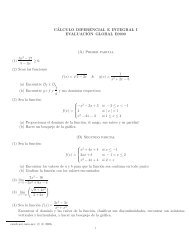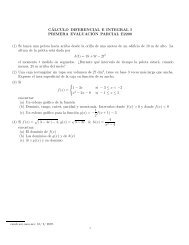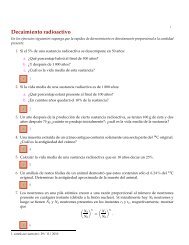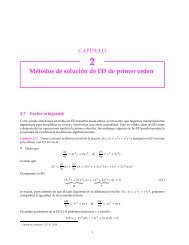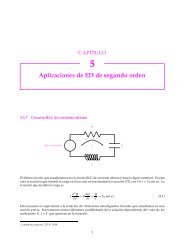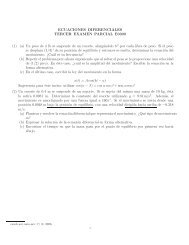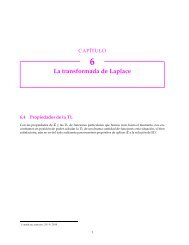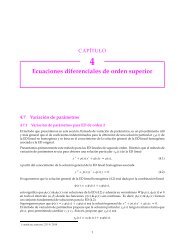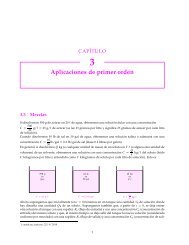Regla de la cadena - Canek - UAM
Regla de la cadena - Canek - UAM
Regla de la cadena - Canek - UAM
You also want an ePaper? Increase the reach of your titles
YUMPU automatically turns print PDFs into web optimized ePapers that Google loves.
2 Cálculo Diferencial e Integral I<br />
Si u D g.x/ es una función <strong>de</strong>rivable en x0, don<strong>de</strong> u0 D g.x0/ y si y D f .u/ es una función <strong>de</strong>rivable<br />
en u0, entonces <strong>la</strong> función y D .f ı g/.x/ es <strong>de</strong>rivable en x0:<br />
.f ı g/ 0 .x0/ D f 0 .u0/g 0 .x0/ D f 0 Œg.x0/ g 0 .x0/ :<br />
H En <strong>la</strong> <strong>de</strong>mostración <strong>de</strong> esta reg<strong>la</strong> <strong>de</strong>sempeña un papel relevante el comportamiento <strong>de</strong> <strong>la</strong> función<br />
u D g.x/ cuando x está cerca <strong>de</strong> x0, ya que si existen puntos x cerca <strong>de</strong> x0 tales que g.x/ D g.x0/,<br />
entonces <strong>la</strong> diferencia g.x/ g.x0/ D 0 genera problemas.<br />
Por eso en esta <strong>de</strong>mostración suponemos que g.x/ ¤ g.x0/ para x cerca <strong>de</strong> x0 y x ¤ x0.<br />
Sea .x/ D .f ı g/.x/ D f Œg.x/ D f .u/ con u D g.x/,<br />
0 .x0/ D lím<br />
x!x0<br />
.x/ .x0/<br />
x x0<br />
.f ı g/.x/ .f ı g/.x0/ f Œg.x/ f Œg.x0/<br />
D lím<br />
D lím<br />
:<br />
x!x0 x x0<br />
x!x0 x x0<br />
Se multiplica y divi<strong>de</strong> por el número diferente <strong>de</strong> cero g.x/ g.x0/:<br />
<br />
0 f Œg.x/ f Œg.x0/<br />
.x0/ D lím<br />
x!x0<br />
D lím<br />
x!x0<br />
<br />
g.x/ g.x0/<br />
D<br />
x x0 g.x/ g.x0/<br />
<br />
f Œg.x/ f Œg.x0/ g.x/ g.x0/<br />
: (*)<br />
g.x/ g.x0/ x x0<br />
Pero <strong>la</strong> <strong>de</strong>rivabilidad <strong>de</strong> g en x0 asegura <strong>la</strong> continuidad <strong>de</strong> g en x0.<br />
Luego, cuando x ! x0, suce<strong>de</strong> que g.x/ ! g.x0/; o sea que u ! u0, cuando x ! x0.<br />
Volviendo a . / vemos<br />
<br />
<br />
<br />
0 f Œg.x/ f Œg.x0/ g.x/ g.x0/<br />
.x0/ D lím<br />
lím<br />
D<br />
x!x0 g.x/ g.x0/ x!x0 x x0<br />
<br />
<br />
<br />
f .u/ f .u0/ g.x/ g.x0/<br />
D lím<br />
lím<br />
D<br />
u!u0 u u0 x!x0 x x0<br />
Por lo tanto,<br />
que es lo que se quería <strong>de</strong>mostrar.<br />
D Œf 0 .u0/Œg 0 .x0/ D f 0 Œg.x0/ g 0 .x0/ :<br />
.f ı g/ 0 .x0/ D f 0 Œg.x0/ g 0 .x0/ ;<br />
En general si u D g.x/ es una función <strong>de</strong>rivable en x & y D f .u/ es una función <strong>de</strong>rivable en u,<br />
entonces <strong>la</strong> función y D .f ı g/.x/ es <strong>de</strong>rivable en x. A<strong>de</strong>más<br />
dy<br />
dx<br />
d<br />
d<br />
D .f ı g/.x/ D<br />
dx dx<br />
Esto se acostumbra sintetizar como:<br />
2<br />
d f Œg.x/ d g.x/<br />
f Œg.x/ D<br />
d g.x/ dx<br />
<br />
d d<br />
D f .u/<br />
du dx g.x/<br />
<br />
:<br />
dy<br />
dx D<br />
dy<br />
du<br />
<br />
du<br />
:<br />
dx<br />
D d f .u/<br />
du<br />
du<br />
dx D


